
This Print, representing the B & N. A Royal Mail Steam Ship Britannia, John Hewitt, Commander, leaving her dock at East Boston on the 3d. of February 1844 on her voyage to Liverpool.
Two-stone lithograph finished with fine hand color of the period. Somewhat toned, water stain at lower left, overall near excellent.
A beautiful, delicately colored example of the scarce first edition of this artistically accomplished, Boston harbor scene with much of the city depicted in the background. The work is a superb example of color lithography combining with delicate hand color to produce an atmospheric image that captures Boston in winter, in which a darkening late-day sky hovers over the snow-covered city. William Sharp (1803-1875), one of the partners of the work's two printers, introduced color lithography to the United States in 1839, when he emigrated from London, having experimented with the process there in the mid-1830's.
The print celebrates the opening up of Boston's icebound harbor, which experienced a once-in-a-generation freeze in January 1844. As stated on the print, Boston's merchants arranged to have a seven mile, 100-foot wide channel cleared so that the Cunard Royal Mail Steamship, Britannia, would be able to maintain its regular service to Liverpool. The west-facing perspective of the print shows the sleek steamer at the Cunard dock in East Boston. Crowds both nearby and along the quay in Boston enthusiastically cheer the freed steamer. This event occasioned such euphoric celebration, as well as this print, because at the time Boston and New York were in intense competition to be the preferred port for the Atlantic steamship trade. Regular Atlantic service had only begun a few years earlier in 1840, and the issue of which city would dominate the trade was far from settled. It has been suggested that, ironically, this print actually hurt Boston's prospects, as it drew attention to the fact that Boston harbor did in fact occasionally freeze over.
The Britannia was 207 feet long, weighed 1,139 tons, made a nine-knot service speed, and carried 115 passengers. The Britannia Class was the Cunard Line's first fleet of wooden paddlers and established the first year round, scheduled Atlantic steamship service in 1840. By 1845, steamships carried half of the transatlantic saloon passengers, and Cunard dominated this trade. Britannia's final crossing was in 1848, and it was then sold to the German navy.
In the 1876 the image depicted here was redrawn on stone and printed by Ferd. Mayer. This second edition can be distinguished by rounded upper corners.
* The Month at Goodspeed's, vols. 10 & 11, pp. 18-19; cf. Slautterback, C. Chromo-mania! pp. 6-10.
Sold
